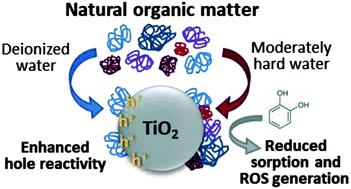当前位置:
X-MOL 学术
›
Environ. Sci.: Nano
›
论文详情
Our official English website, www.x-mol.net, welcomes your
feedback! (Note: you will need to create a separate account there.)
Natural organic matter adsorption conditions influence photocatalytic reaction pathways of phosphate-treated titanium dioxide nanoparticles
Environmental Science: Nano ( IF 5.8 ) Pub Date : 2021-07-05 , DOI: 10.1039/d1en00433f Riya A. Mathew 1, 2, 3, 4 , Gang Wu 3, 4, 5, 6, 7 , Ye Zhang 2, 3, 4, 8, 9 , Sheyda Shakiba 1, 2, 3, 4 , Yan Yao 2, 3, 4, 8, 9 , Ah-Lim Tsai 3, 4, 5, 6, 7 , Stacey M. Louie 1, 2, 3, 4
Environmental Science: Nano ( IF 5.8 ) Pub Date : 2021-07-05 , DOI: 10.1039/d1en00433f Riya A. Mathew 1, 2, 3, 4 , Gang Wu 3, 4, 5, 6, 7 , Ye Zhang 2, 3, 4, 8, 9 , Sheyda Shakiba 1, 2, 3, 4 , Yan Yao 2, 3, 4, 8, 9 , Ah-Lim Tsai 3, 4, 5, 6, 7 , Stacey M. Louie 1, 2, 3, 4
Affiliation

|
Titanium dioxide (TiO2) nanoparticles have been widely studied for water treatment applications; however, natural organic matter (NOM) is often reported to hamper the efficiency of the nanoparticles toward the degradation of target pollutants. Phosphate treatment has been proposed as a potentially facile solution to this problem, as phosphate competes for TiO2 surface sites to diminish the NOM adsorption. However, the potential importance of the conditions of the NOM exposure and the residual NOM remaining after phosphate treatment have not been fully explored. Here, we investigate the reactivity of phosphate-treated TiO2 nanoparticles with NOM coatings adsorbed from two background water chemistries, deionized water (TiO2–NOMDIW) and moderately hard water (TiO2–NOMMHW). Thorough characterization by size exclusion chromatography revealed that the adsorbed NOM was only partially displaced after phosphate treatment, with a higher adsorbed mass and wider variety of NOM species persisting on TiO2–NOMMHW compared to TiO2–NOMDIW. Although the remaining adsorbed NOM did not significantly influence the degradation rate of phenol as a model pollutant, remarkably distinct effects were observed in the degradation of catechol as an oxidative byproduct of phenol, with TiO2–NOMMHW hindering catechol degradation and TiO2–NOMDIW accelerating catechol degradation. The suppressed reactivity for TiO2–NOMMHW was attributed to hindrance of the physical adsorption of catechol to the TiO2 surface by the NOMMHW layer as well as changes in the reactive oxygen species profile as measured by electron paramagnetic resonance (EPR) spectroscopy, whereas the enhanced reactivity for TiO2–NOMDIW was attributed to higher hole formation, suggesting participation of the NOMDIW layer in electron transfer processes. This research highlights the critical importance of the NOM surface coating in directing the mechanisms for pollutant degradation in photocatalytic nano-enabled water treatment applications.
中文翻译:

天然有机物吸附条件影响磷酸盐处理的二氧化钛纳米粒子的光催化反应途径
二氧化钛 (TiO 2 ) 纳米粒子已被广泛研究用于水处理应用。然而,经常有报道称天然有机物 (NOM) 会阻碍纳米颗粒降解目标污染物的效率。磷酸盐处理已被提议作为该问题的潜在简便解决方案,因为磷酸盐竞争 TiO 2表面位点以减少 NOM 吸附。然而,NOM 暴露条件和磷酸盐处理后残留的 NOM 条件的潜在重要性尚未得到充分探讨。在这里,我们研究了磷酸盐处理的 TiO 2纳米粒子与从两种背景水化学物质中吸附的 NOM 涂层的反应性,去离子水(TiO 2 -NOMDIW ) 和中等硬度的水 (TiO 2 –NOM MHW )。通过尺寸排阻色谱彻底表征显示,该吸附的NOM是磷酸盐处理后仅部分地移位,以更高的吸附质量和更广泛的各种NOM物种坚持在TiO的2 -NOM MHW相比的TiO 2 -NOM DIW。尽管剩余吸附的 NOM 对作为模型污染物的苯酚的降解速率没有显着影响,但在作为苯酚氧化副产物的邻苯二酚的降解中观察到了显着不同的影响,TiO 2 -NOM MHW阻碍了邻苯二酚的降解,而 TiO 2 -NOMDIW加速儿茶酚降解。TiO 2 –NOM MHW的抑制反应性归因于NOM MHW层阻碍邻苯二酚物理吸附到 TiO 2表面,以及通过电子顺磁共振 (EPR) 光谱测量的活性氧物种分布的变化,而 TiO 2 –NOM DIW的增强反应性归因于更高的孔形成,表明 NOM DIW 的参与电子转移过程中的层。这项研究强调了 NOM 表面涂层在指导光催化纳米水处理应用中污染物降解机制方面的关键重要性。
更新日期:2021-07-12
中文翻译:

天然有机物吸附条件影响磷酸盐处理的二氧化钛纳米粒子的光催化反应途径
二氧化钛 (TiO 2 ) 纳米粒子已被广泛研究用于水处理应用。然而,经常有报道称天然有机物 (NOM) 会阻碍纳米颗粒降解目标污染物的效率。磷酸盐处理已被提议作为该问题的潜在简便解决方案,因为磷酸盐竞争 TiO 2表面位点以减少 NOM 吸附。然而,NOM 暴露条件和磷酸盐处理后残留的 NOM 条件的潜在重要性尚未得到充分探讨。在这里,我们研究了磷酸盐处理的 TiO 2纳米粒子与从两种背景水化学物质中吸附的 NOM 涂层的反应性,去离子水(TiO 2 -NOMDIW ) 和中等硬度的水 (TiO 2 –NOM MHW )。通过尺寸排阻色谱彻底表征显示,该吸附的NOM是磷酸盐处理后仅部分地移位,以更高的吸附质量和更广泛的各种NOM物种坚持在TiO的2 -NOM MHW相比的TiO 2 -NOM DIW。尽管剩余吸附的 NOM 对作为模型污染物的苯酚的降解速率没有显着影响,但在作为苯酚氧化副产物的邻苯二酚的降解中观察到了显着不同的影响,TiO 2 -NOM MHW阻碍了邻苯二酚的降解,而 TiO 2 -NOMDIW加速儿茶酚降解。TiO 2 –NOM MHW的抑制反应性归因于NOM MHW层阻碍邻苯二酚物理吸附到 TiO 2表面,以及通过电子顺磁共振 (EPR) 光谱测量的活性氧物种分布的变化,而 TiO 2 –NOM DIW的增强反应性归因于更高的孔形成,表明 NOM DIW 的参与电子转移过程中的层。这项研究强调了 NOM 表面涂层在指导光催化纳米水处理应用中污染物降解机制方面的关键重要性。











































 京公网安备 11010802027423号
京公网安备 11010802027423号